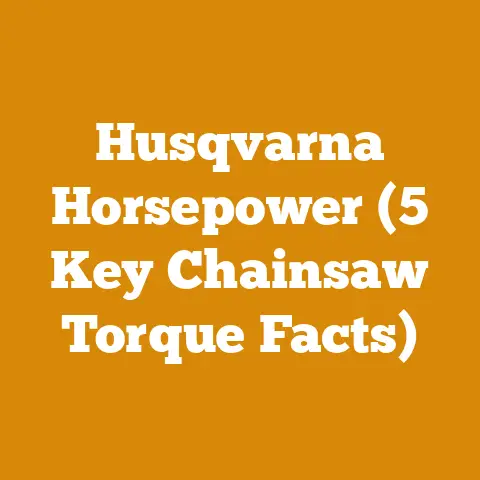App for Tree Identification (Top 5 Dendrology Tools for Woodworkers)
Have you ever stood in a forest, surrounded by towering trees, each with its own unique story etched in its bark and leaves, and wondered, “What kind of tree is that?” As a woodworker, knowing the species of wood you’re working with is more than just a fun fact; it’s crucial for understanding its properties, workability, and ultimately, the success of your project. I remember one time I unknowingly used green ash for a workbench top, only to watch it warp and twist as it dried. A little tree identification knowledge would have saved me a lot of time and frustration! Thankfully, we live in an age where technology can lend a hand. Forget lugging around hefty dendrology textbooks; now there are apps for that! Let’s dive into the world of dendrology apps and explore the top 5 tools that can help woodworkers like us identify trees with ease.
Top 5 Dendrology Tools for Woodworkers: A Cost-Conscious Guide
Before we jump into the apps, it’s important to acknowledge that tree identification is not an exact science. Factors like regional variations, tree age, and environmental conditions can all influence the appearance of a tree. But with a little practice and the help of these apps, you’ll be identifying trees like a seasoned forester in no time.
1. PictureThis: The Visual Learner’s Dream
- Overview: PictureThis is a plant identification app that uses image recognition technology to identify plants and trees from photos. Simply snap a picture of a leaf, bark, or even the entire tree, and the app will provide a list of possible matches, along with detailed information about each species.
- Cost: PictureThis offers a free trial, but the full version requires a subscription. The pricing varies depending on the subscription length. As of October 2024, you can expect to pay around \$30-\$60 per year for a premium subscription.
-
Pros:
- User-friendly interface.
- High accuracy rate, especially with clear photos.
- Extensive database of plants and trees.
- Offers care tips and information about plant diseases.
- Available on both iOS and Android.
-
Cons:
-
Requires a subscription for full access.
- Accuracy can be affected by poor image quality or unusual tree variations.
- Some users report aggressive marketing tactics.
- Woodworker Value: The visual nature of PictureThis makes it excellent for quick identification in the field. The care tips, while not directly relevant to woodworking, can provide insights into the growing conditions and potential characteristics of the wood. Imagine you are sourcing timber locally; this can help you identify the tree and its growing environment.
- Cost Considerations: The annual subscription cost might seem high, but I consider it a worthwhile investment if you regularly need to identify trees. Think about it: misidentifying a tree and using the wrong wood for a project could cost you far more in materials and time.
2. iNaturalist: The Citizen Scientist’s Choice
- Overview: iNaturalist is a joint initiative of the California Academy of Sciences and the National Geographic Society. It’s a social network for naturalists, scientists, and anyone who wants to learn more about the natural world. Users can upload photos of plants and animals, and the iNaturalist community will help identify them.
- Cost: iNaturalist is completely free to use.
-
Pros:
- Free and open-source.
- Large and active community of experts.
- Data is used for scientific research.
- Available on both iOS and Android.
-
Cons:
-
Identification relies on community input, so it may take time to get a response.
- Accuracy can vary depending on the expertise of the identifiers.
- User interface can be a bit clunky compared to other apps.
- Woodworker Value: iNaturalist is a great resource for learning about local flora and fauna. The community aspect allows you to connect with experts and get feedback on your identifications. Plus, you’re contributing to scientific research! I use it to check my own identifications and learn about the distribution of different tree species in my area.
- Cost Considerations: Since iNaturalist is free, there are no direct costs. However, you might consider donating to the organization to support its work.
3. LeafSnap: The High-Tech Identifier
- Overview: LeafSnap is a free mobile app that uses visual recognition software to help identify tree species from leaf photos. Developed by researchers from Columbia University, the University of Maryland, and the Smithsonian Institution, LeafSnap contains high-resolution images of leaves, flowers, fruits, seeds, and bark.
- Cost: LeafSnap is free to download and use.
-
Pros:
- Free and easy to use.
- High-resolution images for accurate identification.
- Developed by reputable research institutions.
- Available on both iOS and Android.
-
Cons:
-
Primarily focuses on leaf identification, which may not be helpful in winter.
- Accuracy can be affected by damaged or atypical leaves.
- Limited geographic coverage in some regions.
- Woodworker Value: LeafSnap’s focus on leaves makes it ideal for identifying trees during the growing season. The high-resolution images allow you to compare your leaf samples with detailed photos of different species. I find it particularly useful for distinguishing between similar-looking oak species.
- Cost Considerations: LeafSnap is a completely free tool, making it a valuable addition to any woodworker’s toolkit.
4. PlantNet: The Collaborative Platform
- Overview: PlantNet is a citizen science project that uses image recognition to identify plants and trees. Users can upload photos, and the app will suggest possible matches based on its database. The app also allows users to contribute to the database by identifying and tagging plants.
- Cost: PlantNet is free to download and use.
-
Pros:
- Free and open-source.
- Large and growing database of plants and trees.
- Collaborative platform allows users to contribute to the database.
- Available on both iOS and Android.
-
Cons:
-
Accuracy can vary depending on the quality of the images and the expertise of the identifiers.
- User interface can be a bit overwhelming at first.
- Identification relies on community input, so it may take time to get a response.
- Woodworker Value: PlantNet’s collaborative nature makes it a valuable resource for learning about local flora. The app also allows you to contribute to the database by identifying and tagging plants, helping to improve its accuracy over time. I appreciate its global focus, which is helpful when I’m researching wood species from different regions.
- Cost Considerations: As a free and open-source platform, PlantNet offers a cost-effective way to identify trees and contribute to scientific research.
5. Seek by iNaturalist: The Gamified Learning Experience
- Overview: Seek by iNaturalist is a kid-friendly version of iNaturalist that uses image recognition to identify plants and animals. The app also includes challenges and badges to encourage users to learn more about the natural world.
- Cost: Seek by iNaturalist is completely free to use.
-
Pros:
- Free and easy to use.
- Gamified learning experience makes it fun for all ages.
- Uses the same database as iNaturalist, ensuring accuracy.
- Available on both iOS and Android.
-
Cons:
-
Focuses on broad identification, which may not be detailed enough for some woodworkers.
- Limited features compared to iNaturalist.
- Woodworker Value: While Seek is designed for kids, it can still be a useful tool for woodworkers who are new to tree identification. The gamified learning experience makes it fun and engaging, and the app uses the same database as iNaturalist, ensuring accuracy. I sometimes use it as a quick and easy way to get a general idea of what kind of tree I’m looking at.
- Cost Considerations: Seek is completely free, making it a great option for budget-conscious woodworkers.
Cost Breakdown: Investing in Knowledge
Let’s break down the costs associated with these dendrology apps. As you can see, the price range varies widely, from free to around \$60 per year.
| App | Cost |
|---|---|
| PictureThis | \$30-\$60/year |
| iNaturalist | Free |
| LeafSnap | Free |
| PlantNet | Free |
| Seek by iNaturalist | Free |
Now, let’s consider the cost of not knowing your wood.
- Material Costs: Using the wrong wood for a project can lead to warping, cracking, and other issues, resulting in wasted materials. The cost of lumber varies greatly depending on the species, but you can easily spend hundreds of dollars on a single project.
- Labor Costs: If your project fails due to using the wrong wood, you’ll have to spend time and effort redoing it. Labor costs can quickly add up, especially if you’re paying someone else to do the work.
- Tool Costs: Working with the wrong wood can also damage your tools. For example, using a softwood for a project that requires a hardwood can dull your blades and bits much faster.
- Frustration Costs: Let’s not forget the frustration and disappointment that comes with a failed project. This can be especially discouraging for beginner woodworkers. I remember one time I tried to build a dining table out of pine, thinking it would be a cost-effective option. The table looked great at first, but it quickly became dented and scratched. I ended up having to rebuild it using maple, which was a much better choice. The initial cost savings of using pine were completely negated by the cost of the wasted materials and my time.
Beyond the Apps: Expanding Your Dendrology Knowledge
While these apps are excellent tools, they shouldn’t be your only source of information. Here are some other ways to expand your dendrology knowledge:
- Field Guides: Invest in a good field guide to the trees of your region. These guides typically include detailed descriptions and illustrations of different species.
- Local Experts: Connect with local foresters, arborists, or members of your local woodworking club. They can provide valuable insights and advice.
- Online Resources: There are many online resources available, such as websites, forums, and online courses.
- Hands-On Experience: The best way to learn about trees is to get out in the field and start identifying them. Take a walk in the woods and try to identify the trees you see. Take notes and photos, and compare them with your field guide or app.
Cost Optimization Strategies for Woodworkers
Here are some practical tips for cost optimization and budget management in wood processing or firewood preparation projects, keeping in mind the importance of tree identification:
- Know Your Wood: Accurately identifying the wood species is the first step. This ensures you’re selecting the right material for the job, minimizing waste and potential project failures.
- Source Locally: Buying timber locally can save you money on transportation costs and support your local economy. Look for local sawmills or wood suppliers. Knowing the tree species allows you to negotiate better prices with local suppliers.
- Buy in Bulk: If you’re planning a large project, consider buying timber in bulk. This can often result in significant cost savings.
- Use Reclaimed Wood: Reclaimed wood is a great way to save money and reduce your environmental impact. Look for reclaimed wood at salvage yards or demolition sites. However, always properly identify the species of reclaimed wood to ensure it’s suitable for your project.
- Sharpen Your Tools: Keeping your tools sharp will not only make your work easier but also reduce the risk of damaging your materials. Dull tools can tear the wood fibers, resulting in a poor finish and wasted material.
- Plan Your Cuts Carefully: Before you start cutting, take the time to plan your cuts carefully. This will help you minimize waste and ensure that you have enough material for your project.
- Dry Your Wood Properly: If you’re using green wood, make sure to dry it properly before starting your project. Improperly dried wood can warp, crack, or shrink, ruining your project. Understand the drying characteristics of different wood species (knowledge gained from proper identification) to avoid costly mistakes.
- Negotiate Prices: Don’t be afraid to negotiate prices with your suppliers. Many suppliers are willing to offer discounts, especially if you’re buying in bulk or paying in cash.
- Rent Equipment: If you only need a particular tool for a short period, consider renting it instead of buying it. This can save you a lot of money, especially for expensive tools like chainsaws or wood splitters.
- Maintain Your Equipment: Regularly maintain your equipment to keep it in good working order. This will help you avoid costly repairs and extend the life of your tools.
Case Study: The Firewood Fiasco
I once had a client who wanted to save money on firewood by sourcing it himself. He thought all firewood was created equal and didn’t bother to identify the tree species. He ended up cutting down a bunch of poplar trees, which are known for their low heat output and quick burning time. He spent a lot of time and effort cutting and splitting the wood, only to find that it didn’t provide enough heat to warm his home. He ended up having to buy firewood from a reputable supplier anyway, effectively doubling his costs.
This case study highlights the importance of tree identification in firewood preparation. Different tree species have different heat outputs, burning times, and smoking characteristics. By identifying the tree species before cutting it down, you can ensure that you’re getting the most value for your time and effort.
Calculations and Formulas: Mastering Wood Volume
Understanding how to calculate wood volume is crucial for budgeting and cost management in wood processing. Here are some common calculations and formulas:
-
Board Feet: A board foot is a unit of measurement for lumber. It’s defined as a piece of wood that is 1 inch thick, 12 inches wide, and 12 inches long. The formula for calculating board feet is:
Board Feet = (Thickness in inches x Width in inches x Length in inches) / 144* Cords: A cord is a unit of measurement for firewood. It’s defined as a stack of wood that is 4 feet high, 4 feet wide, and 8 feet long. The formula for calculating cords is:Cords = (Height in feet x Width in feet x Length in feet) / 128* Log Volume: There are several formulas for estimating the volume of logs, such as the Doyle Log Scale, the Scribner Log Scale, and the International 1/4-inch Log Scale. These formulas take into account the diameter and length of the log to estimate the number of board feet that can be sawn from it.
Actionable Takeaways: Your Next Steps
So, where do you go from here?
- Download a Dendrology App: Choose one of the apps discussed in this article and start using it to identify trees in your area.
- Invest in a Field Guide: A good field guide will provide detailed information about the trees in your region.
- Connect with Local Experts: Reach out to local foresters, arborists, or members of your local woodworking club.
- Practice, Practice, Practice: The more you practice identifying trees, the better you’ll become.
- Consider a Subscription: If you find that you’re using a particular app frequently, consider subscribing to the premium version for access to more features and information.
- Apply Cost Optimization Strategies: Implement the cost optimization strategies discussed in this article to save money on your wood processing and firewood preparation projects.
- Stay Informed: Keep up-to-date on the latest trends and technologies in the woodworking industry.
- Share Your Knowledge: Share your knowledge with others and help them learn about the importance of tree identification.
Final Thoughts: The Woodworker’s Wisdom
As woodworkers, we have a responsibility to understand and appreciate the natural world around us. By learning about trees and their properties, we can make more informed decisions about the materials we use and create projects that are both beautiful and sustainable. Tree identification is not just a skill; it’s a gateway to a deeper understanding of the wood we work with, the forests we depend on, and the planet we share. So, embrace the challenge, explore the world of dendrology, and let your newfound knowledge guide you in your woodworking endeavors. After all, a woodworker who knows their wood is a woodworker who can truly create something special.






